Appointment of Archbishop Tobin and tornado in Henryville top local stories
By Brandon A. Evans
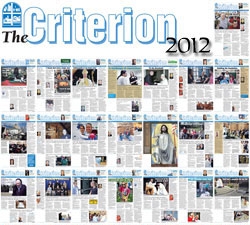 The appointment of Archbishop Joseph W. Tobin as our sixth archbishop, the response to tornado damage in Henryville by St. Francis Xavier Parish and others, and the city of Indianapolis hosting the National Black Catholic Congress were voted the top three local news stories of 2012.
The appointment of Archbishop Joseph W. Tobin as our sixth archbishop, the response to tornado damage in Henryville by St. Francis Xavier Parish and others, and the city of Indianapolis hosting the National Black Catholic Congress were voted the top three local news stories of 2012.
Other stories of note include coverage of the local response to the Department of Health and Human Services’ (HHS) mandate, Bishop Christopher J. Coyne’s ad limina visit to Rome with Indiana’s other bishops and the ordination of 16 new permanent deacons.
Working in the custom of other news agencies, The Criterion editorial staff votes each year for the top 10 local stories that were published in our newspaper.
Many of the stories selected this year were made up of several individual articles. Links to those original stories, as well as other content of interest, can be found below.
Among the hundreds of locally produced news stories during 2012, here is our “Top 10” list:
1. Most Rev. Joseph W. Tobin, C.Ss.R., is appointed the sixth archbishop of Indianapolis
 Catholics in central and southern Indiana had been praying for more than a year for the news which came early in the morning on Oct. 18—Pope Benedict XVI had chosen a new shepherd to succeed Archbishop Emeritus Daniel M. Buechlein, who resigned in 2011 due to health reasons.
Catholics in central and southern Indiana had been praying for more than a year for the news which came early in the morning on Oct. 18—Pope Benedict XVI had chosen a new shepherd to succeed Archbishop Emeritus Daniel M. Buechlein, who resigned in 2011 due to health reasons.
A Redemptorist priest who formerly served as his order’s superior general, Archbishop Joseph W. Tobin was at the time serving the Vatican as secretary of the Congregation for Institutes of Consecrated Life and Societies of Apostolic Life.
He was second in charge of the Vatican dicastery that helps oversee the life and ministry of more than 1 million men and women religious.
Archbishop Tobin said his first reaction to the new appointment was one of surprise.
“One of my favorite definitions for faith is ‘an openness to be surprised by God,’ ” he said, reflecting on how his appointment came shortly after the start of the pope’s international Church observance of the “Year of Faith.”
Archbishop Tobin was formally installed during a Mass at SS. Peter and Paul Cathedral in Indianapolis on Dec. 3—the feast of St. Francis Xavier, archdiocesan patron. The Mass was attended by two dozen bishops, more than a hundred priests, and hundreds of other family members, dignitaries and parish representatives.
News coverage:
Related:
2. St. Francis Xavier Parish in Henryville helps the community rebuild after a deadly tornado
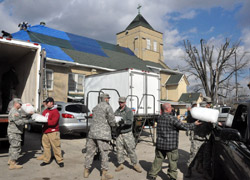 On the afternoon of March 2, a tornado bore down on the town of Henryville, one of many storms that cut across the state and region that day leaving dozens dead.
On the afternoon of March 2, a tornado bore down on the town of Henryville, one of many storms that cut across the state and region that day leaving dozens dead.
Henryville was devastated. Schools, businesses and homes were destroyed.
“It’s a difficult thing to see,” said Father Steven Schaftlein, pastor of St. Francis Xavier Parish in Henryville. “[But] the people here have faith and hope.”
The tornado caused $250,000 in structural damage to St. Francis Xavier Church, but the church, which was centrally located in the disaster area, was quickly filled with donations of clothing, food and tools.
Along with other parishes, including St. John the Baptist Parish in Osgood, archdiocesan Catholic Charities staff members immediately began to help with the work of disaster relief efforts in southern Indiana, which includes a long-term commitment that is still ongoing.
During a trip to Henryville in late March, Bishop Christopher J. Coyne, then apostolic administrator, offered a Mass.
“We can see the devastation when a tragedy like this occurs, but we can also see how God works,” he said. “God works through the people around us, answering our prayers through the people in our community.”
Bishop Coyne returned on Nov. 25 to rededicate the church after all the repairs were completed.
News coverage:
Related:
3. More than 2,200 people gather in Indianapolis for the National Black Catholic Congress
 Every five years, black Catholics from around the country gather for the National Black Catholic Congress, which was held on July 19-21 at the JW Marriott in downtown Indianapolis.
Every five years, black Catholics from around the country gather for the National Black Catholic Congress, which was held on July 19-21 at the JW Marriott in downtown Indianapolis.
Dominican Father Reginald Whitt, a law professor at St. Thomas University in St. Paul, Minn., gave the opening address, which looked at the history of the congress.
Initial meetings were held in the late 19th century, and dealt with the response to racism and the need for better education for their children.
“Some of those issues persist,” Father Reginald said. “Some assert themselves anew. And black Catholics must constantly and repeatedly confront them.”
After the re-emergence of a distinctly black Catholic identity following the Second Vatican Council, the U.S. black Catholic bishops issued a pastoral letter titled “What We Have Seen and Heard.”
“We were authentically black,” Father Reginald said. “We were truly Catholic. And, hence, we were called to evangelization. Thus began the current era of the Black Catholic Congress.”
Deacon Lawrence Houston of St. Peter Claver Parish in New Orleans said his positive experience during the opening session started with the music.
“It just touched my spirit,” Deacon Houston said. “And just to be among so many African-Americans who know who they are as Christians, and … are not afraid to let people know that we are black and we are Catholic, and that there’s no separation in that was a powerful thing.”
News coverage:
Related:
4. Local Catholics stand against the HHS mandate
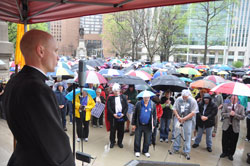 On Jan. 20, the U.S. Department of Health and Human Services (HHS) reaffirmed a rule forcing virtually all private health care plans to cover sterilization, abortifacients and contraception.
On Jan. 20, the U.S. Department of Health and Human Services (HHS) reaffirmed a rule forcing virtually all private health care plans to cover sterilization, abortifacients and contraception.
The exemption for “religious employers” was crafted so narrowly as to not include the vast majority of faith-based organizations, which include Catholic hospitals, universities and charities.
In the wake of the decision, the U.S. bishops and the faithful have spoken loudly about this issue, which Bishop Coyne called “one that challenges the rights of all people of faith to live their lives according to the beliefs and dictates of that faith.”
On March 23, 700 people from across central Indiana gathered at the Indiana Statehouse in Indianapolis in the rain for a rally that included religious and civic leaders.
“We are just one of 140 cities across the country that are simultaneously having these rallies to stand up for religious freedom,” said Marc Tuttle, president of Right to Life of Indianapolis.
A similar rally, attracting even more people, took place on June 8 at the statehouse.
Many parishes and individuals also participated in a call to prayer, education and action as part of the national “Fortnight for Freedom,” which took place from June 21 to July 4.
News coverage:
Related:
5. Bishop Christopher J. Coyne meets with Pope Benedict XVI during the ad limina visit of the Indiana bishops
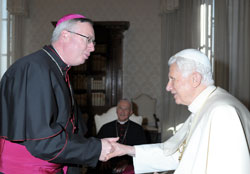 Bishop Christopher J. Coyne, then apostolic administrator, represented the archdiocese during a Feb. 9 meeting with Pope Benedict XVI at the Vatican.
Bishop Christopher J. Coyne, then apostolic administrator, represented the archdiocese during a Feb. 9 meeting with Pope Benedict XVI at the Vatican.
The meeting, which was held with the other bishops of Indiana, was part of the ad limina visit of the bishops of Illinois, Indiana and Wisconsin with the pope and leaders of various offices at the Vatican.
“Each diocesan bishop around the world makes an ad limina visit every five to eight years,” reporter Sean Gallagher noted in our news coverage. “In advance of the trip, surveys about the life of the diocese are filled out by the bishop and his pastoral staff for review by the pope and various cardinals and bishops who assist him.”
“It was a very special moment to be able to sit down for 20 minutes with [the pope],” Bishop Coyne said. “We sat down and had a conversation. He asked questions as he listened to what we had to say. He was very enthusiastic about the work that’s going on in Indiana and in the Church.”
News coverage:
Related:
6. Sixteen men are ordained permanent deacons
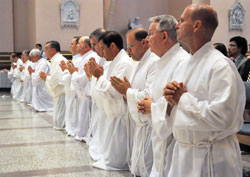 The archdiocese ordained its second class of permanent deacons on June 23 at SS. Peter and Paul Cathedral in Indianapolis.
The archdiocese ordained its second class of permanent deacons on June 23 at SS. Peter and Paul Cathedral in Indianapolis.
The 16 men had been preparing for the day for years. Prior to their class, only one other group of permanent deacons had been ordained for the archdiocese in 2008.
The new deacons will minister at parishes as well as jails, hospitals and nursing homes. Liturgically, they are permitted to baptize, witness marriages and preside over funeral services. Often, they will proclaim the Gospel and preach the homily during a Mass.
“Consecrated by the laying on of hands that comes down to us from the Apostles, and bound more closely to the altar, they will perform works of charity in the name of the Lord God,” Bishop Coyne said. “With the help of God, they are to go about all these duties in such a way that you will recognize them as disciples of him who came not to be served but to serve.”
News coverage:
Related:
7. Marian University celebrates its 75th anniversary and $153 million in gifts
 More than 2,000 supporters of Marian University in Indianapolis—including the Sisters of St. Francis of Oldenburg, who founded the college—joined president Daniel Elsener at an Oct. 19 dinner to celebrate the 75th anniversary of the institution.
More than 2,000 supporters of Marian University in Indianapolis—including the Sisters of St. Francis of Oldenburg, who founded the college—joined president Daniel Elsener at an Oct. 19 dinner to celebrate the 75th anniversary of the institution.
Marian’s enrollment is nearly 2,600 students, it has a thriving football program which captured the national title in the National Association of Intercollegiate Athletics (NAIA) on Dec. 14, and it is on track to open its new College of Osteopathic Medicine.
It was announced at the anniversary celebration that corporate and individual donors had pledged $153 million in gifts to extend the mission of Marian University to provide quality Catholic higher education for years to come.
“I have been simply overwhelmed—sometimes to tears—to see the generosity, and what people will sacrifice to do something great,” Elsener said. “… I just greatly appreciate the goodness I’ve found in so many people.”
News coverage:
Related:
8. Indiana school voucher law is upheld by a county judge
 From a Criterion staff report on Jan. 20: “A Marion County Superior Court judge has ruled that the Indiana school voucher program is constitutional—a ruling that means the nearly 4,000 students who benefit from the state’s school choice program can continue to attend non-public schools with state funds.
From a Criterion staff report on Jan. 20: “A Marion County Superior Court judge has ruled that the Indiana school voucher program is constitutional—a ruling that means the nearly 4,000 students who benefit from the state’s school choice program can continue to attend non-public schools with state funds.
“In his ruling on Jan. 13, Judge Michael Keele upheld the new program that went into effect for the 2011-12 school year. The judge stated that the voucher system is designed to benefit students and their families—not private, religious schools—because the money is given directly to the students’ families.”
News coverage:
Related:
9. Deacon Jerry Byrd is ordained to the priesthood
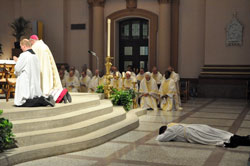 After having prayed, studied and prepared for years as an archdiocesan seminarian, Deacon Jerry Byrd was ordained a priest during a Mass on June 2 at SS. Peter and Paul Cathedral in Indianapolis.
After having prayed, studied and prepared for years as an archdiocesan seminarian, Deacon Jerry Byrd was ordained a priest during a Mass on June 2 at SS. Peter and Paul Cathedral in Indianapolis.
Born into a Baptist family, he had a powerful experience of the Eucharist when he was 17 and felt called to the Catholic faith. Fourteen years later, he was ordained a priest.
“It really proves to me that God had a purpose for my life,” Father Byrd said. “The beauty of that is overwhelming. It’s overwhelming to think that it’s been 14 years and, yet, here I am just beginning. Who knows what the future holds?”
News coverage:
Related:
10. Former Anglicans are welcomed into the Catholic Church at the cathedral
 Seventeen Anglican Christians became Catholics on April 7 at SS. Peter and Paul Cathedral in Indianapolis according to a set of provisions established by Pope Benedict XVI in his 2009 apostolic constitution “Anglicanorum Coetibus.”
Seventeen Anglican Christians became Catholics on April 7 at SS. Peter and Paul Cathedral in Indianapolis according to a set of provisions established by Pope Benedict XVI in his 2009 apostolic constitution “Anglicanorum Coetibus.”
Sean Gallagher reported on the details.
“The rules in this document were drawn up after several groups of Anglican Christians from around the world asked the pope for a way to become Catholics while still maintaining aspects of their spiritual heritage.
“Earlier this year, Pope Benedict approved the establishment of the Personal Ordinariate of the Chair of St. Peter, which functions like a diocese for former Anglicans in the United States and Canada.
“The 17 members of the St. Joseph of Arimathea Society in Indianapolis that were welcomed into the Church by Bishop Christopher J. Coyne, apostolic administrator, are the fourth group of former Anglicans to join the ordinariate.”
News coverage:
Related:





 Bishop Christopher J. Coyne, then apostolic administrator, represented the archdiocese during a Feb. 9 meeting with Pope Benedict XVI at the Vatican.
Bishop Christopher J. Coyne, then apostolic administrator, represented the archdiocese during a Feb. 9 meeting with Pope Benedict XVI at the Vatican.



